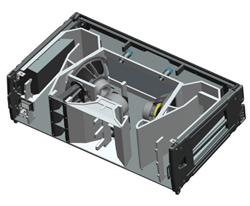
Phase-Coherent
The FIR filters are employed to manipulate the frequency response, and more importantly, the phase response of individual cells in the array. This lets the array better match its coverage to the audience listening area.
It also allows the array to modify its coverage to match the audience listening area without changing physical orientation or “hang” – instead, coverage can be electronically adjusted without physically changing the array.
MLA operates on the principle that the best way to create coherent summation across the audience area is not by producing an isophasic wavefront from the array, but by producing a phase-coherent wavefront in the audience plane.
This is because the audience surface and the array’s front are rarely in the same plane.
This system can change its vertical coverage by plus or minus 5 degrees, and not the simple HF beam-steering found on some architectural columns, but full-bandwidth coverage adjustments.
Five degrees may not sound like a lot, but towards the rear of large venues, it can mean 100 feet or more.
In order for a computer to correctly model the behavior of a loudspeaker system, Martin Audio discovered that the largest unaccounted effect in line arrays is that of adjacent loudspeakers in the array, whether they’re driven or not.
The physical presence of adjacent loudspeakers, or indeed any physical object next to a loudspeaker, not only changes its amplitude response but also its directivity, and the result can be errors in the midrange of up to 8 dB, a fact well-known by many system technicians using high-performance measurement systems.
DISPLAY2 software provides automatic and intelligent optimization of he loudspeaker array. MLA employs cellular drive processing of individual array elements, what Martin Audio calls “Elemental EQ” (or “EEQ” for short).
DISPLAY2 allows the system engineer to control several factors such as frequency response smoothness, front-to-back SPL evenness and leakage beyond the defined listening area.
These several objective functions can be combined and blended, but there are trade-offs between the various objectives.
Listening area coverage can also be increased or shortened by up to 10 degrees. The array can be programmed to avoid coverage in the middle, such as balcony fronts with nulls up to -12 dB.

